关于时间的英语表达
有关时间的英语表达
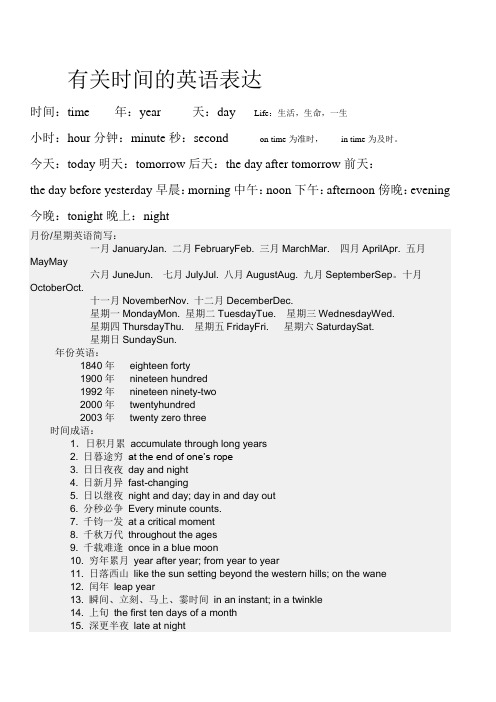
有关时间的英语表达时间:time 年:year 天:day Life:生活,生命,一生小时:hour分钟:minute秒:second on time为准时,in time为及时。
今天:today明天:tomorrow后天:the day after tomorrow前天:the day before yesterday早晨:morning中午:noon下午:afternoon傍晚:evening 今晚:tonight晚上:night月份/星期英语简写:一月JanuaryJan. 二月FebruaryFeb. 三月MarchMar. 四月AprilApr. 五月MayMay六月JuneJun. 七月JulyJul. 八月AugustAug. 九月SeptemberSep。
十月OctoberOct.十一月NovemberNov. 十二月DecemberDec.星期一MondayMon. 星期二TuesdayTue. 星期三WednesdayWed.星期四ThursdayThu. 星期五FridayFri. 星期六SaturdaySat.星期日SundaySun.年份英语:1840年eighteen forty1900年nineteen hundred1992年nineteen ninety-two2000年twentyhundred2003年twenty zero three时间成语:1.日积月累accumulate through long years2. 日暮途穷at the end of one’s rope3. 日日夜夜day and night4. 日新月异fast-changing5. 日以继夜night and day; day in and day out6. 分秒必争Every minute counts.7. 千钧一发at a critical moment8. 千秋万代throughout the ages9. 千载难逢once in a blue moon10. 穷年累月year after year; from year to year11. 日落西山like the sun setting beyond the western hills; on the wane12. 闰年leap year13. 瞬间、立刻、马上、霎时间in an instant; in a twinkle14. 上旬the first ten days of a month15. 深更半夜late at night16. 时过境迁Time has changed.17. 瞬息万变change at every moment18 遗臭万年be cursed for ever by posterity; remain infamous in history19 无时无刻all the time; constantly20 猴年马月donkey’s years21 与日俱增be on the increase day by day22 蒸蒸日上grow more and more prosperous23 有朝一日someday; when the day comes24 指日可待can be expected soon25 一日千里at tremendous speed; by leaps and bounds26 一年到头all the year round; throughout the year27 有生之年the rest of one’s life; one’s remaining years28 新纪元new era; new epoch29 延年益寿prolong one’s life。
【英语语法】英语时间表达法知识点汇总(附练习及答案)

【英语语法】英语时间表达法知识点汇总(附练习及答案)时间表达法一直是英语考试的重点,而且,在日常生活中我们也会经常用到。
郭老师总结了关于时间表达的知识点,娃们一起来学习!一. 时间点的表达1、所有的时间都可以用“小时+ 分钟”直接读:6:10 six ten8:30 eight thirty2:40 two forty2、如果所表述的时间在半小时之内,可以用“分钟+ past + 小时”:6:10 ten past six4:20 twenty past four10:25 twenty-five past ten3、如果所表述的时间在半小时之外,可以用“(相差的)分钟+ to + (下一)小时”:10:35 twenty-five to eleven5:50 ten to six9:49 eleven to ten4、如果所表述的时间恰好为半小时,可以用“half + past + 小时”:11:30 half past eleven2:30 half past two5、如果所表述的分钟和15有关,就有三种表达法:(15分钟又叫一刻钟:a quarter)9:15 nine fifteen ; fifteen past nine ; a quarter past nine3:45 three forty-five ; fifteen to four ; a quarter to four6、整点的表达:现在是两点整。
It's two./It's two o'clock.另外英语中的noon 和midnight 可分别直接表示白天和夜晚的12点:It's (twelve) noon. 现在是中午十二点。
It's (twelve) midnight. 现在是半夜零点。
7、大约时间:It's almost two. 马上到两点了。
It's not quite two. 还不到两点。
时间的直接表达法和间接表达法

英语中的时间表达法
用英语表达时间通常有以下两种方法:
一、直接表达法
1.整点时间用“钟点数(基数词)+o'clock ”这种形式来表达,也可以省略o'clock.
如:eight(o'clock) 8:00
ten(o'clock) 10:00
2.用基数词按照“钟点数+分钟数”的顺序直接表达时间。
如:six seven 6:07
eight fifteen 8:15
二、间接表达法
1.如果分钟数少于或等于30分钟,用“分钟数+past(过)+钟点数”来表达,意为“几点过几分”。
如:fifteen past seven 7:15
twenty part four 4:20
2.如果分钟数超过30分钟,用“(60—原分钟数)+to(差)+(原钟点数+1)”来表示,意为“差几分到几点”
如:five to eleven 10:55
fifteen to eight7:45
有关于时间的格言
Time flies. 时光飞逝
Time is money. 一寸光阴一寸金。
Time tries truth. 时间验证真理。
Time will tell. 时间证明一切。
Tomorrow comes never. 切莫依赖明天。
时间的英文表达法
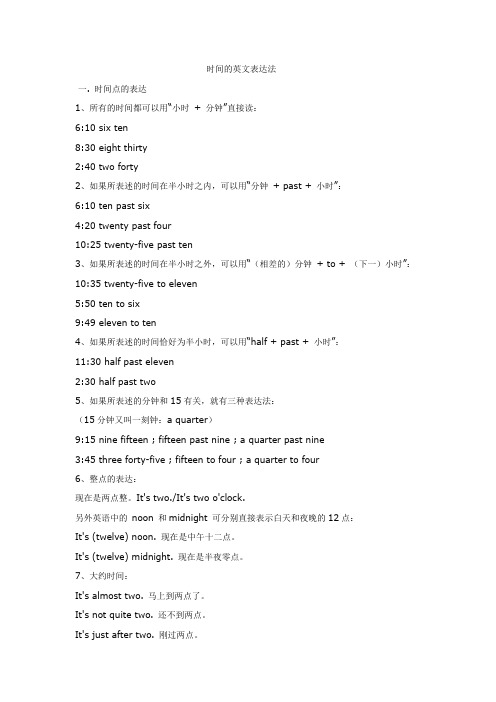
时间的英文表达法一. 时间点的表达1、所有的时间都可以用“小时+ 分钟”直接读:6:10 six ten8:30 eight thirty2:40 two forty2、如果所表述的时间在半小时之内,可以用“分钟+ past + 小时”:6:10 ten past six4:20 twenty past four10:25 twenty-five past ten3、如果所表述的时间在半小时之外,可以用“(相差的)分钟+ to + (下一)小时”:10:35 twenty-five to eleven5:50 ten to six9:49 eleven to ten4、如果所表述的时间恰好为半小时,可以用“half + past + 小时”:11:30 half past eleven2:30 half past two5、如果所表述的分钟和15有关,就有三种表达法:(15分钟又叫一刻钟:a quarter)9:15 nine fifteen ; fifteen past nine ; a quarter past nine3:45 three forty-five ; fifteen to four ; a quarter to four6、整点的表达:现在是两点整。
It's two./It's two o'clock.另外英语中的noon 和midnight 可分别直接表示白天和夜晚的12点:It's (twelve) noon. 现在是中午十二点。
It's (twelve) midnight. 现在是半夜零点。
7、大约时间:It's almost two. 马上到两点了。
It's not quite two. 还不到两点。
It's just after two. 刚过两点。
8、若想表明是上午,可在时间后加上a.m.如:thirteen past six a.m.(上午六点十三分)。
英语中时间表达法
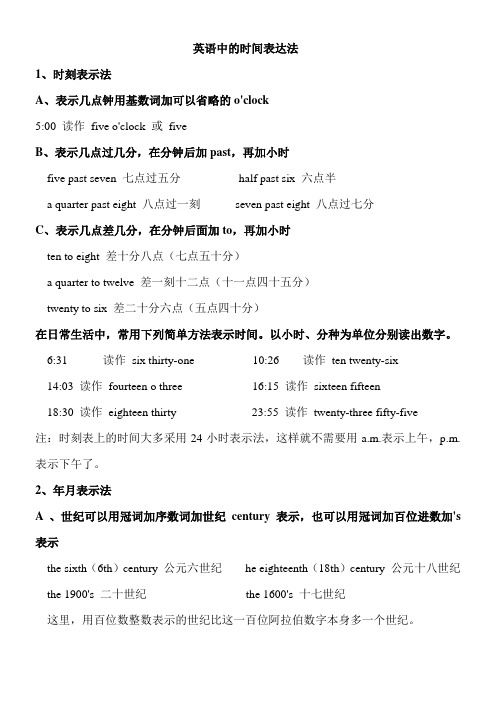
英语中的时间表达法1、时刻表示法A、表示几点钟用基数词加可以省略的o'clock5:00 读作five o'clock 或fiveB、表示几点过几分,在分钟后加past,再加小时five past seven 七点过五分half past six 六点半a quarter past eight 八点过一刻seven past eight 八点过七分C、表示几点差几分,在分钟后面加to,再加小时ten to eight 差十分八点(七点五十分)a quarter to twelve 差一刻十二点(十一点四十五分)twenty to six 差二十分六点(五点四十分)在日常生活中,常用下列简单方法表示时间。
以小时、分种为单位分别读出数字。
6:31读作six thirty-one 10:26读作ten twenty-six14:03 读作fourteen o three 16:15 读作sixteen fifteen18:30 读作eighteen thirty 23:55 读作twenty-three fifty-five注:时刻表上的时间大多采用24小时表示法,这样就不需要用a.m.表示上午,p.m.表示下午了。
2、年月表示法A 、世纪可以用冠词加序数词加世纪century表示,也可以用冠词加百位进数加's 表示the sixth(6th)century 公元六世纪he eighteenth(18th)century 公元十八世纪the 1900's 二十世纪the 1600's 十七世纪这里,用百位数整数表示的世纪比这一百位阿拉伯数字本身多一个世纪。
B、年代用冠词及基数词表示的世纪加十位整数的复数形式构成in the 1930s(in the thirties of the twentieth century或in the nineteen thirties)在二十世纪三十年代in the 1860's(in the sixties of the 19th century或in the eighteen sixties在十九世纪六十年代C、表示某年代的早期、中期和晚期,可以在冠词后,年代前添加early,mid-,late in the early 1920's 在二十世纪二十年代早期in the mid-1950's 在二十世纪五十年代中期D、年月日表示法年份用基数词表示,一般写为阿拉伯数字,读时可以以hundred为单位,也可以以世纪、年代为单位分别来读。
英语中时间的表达
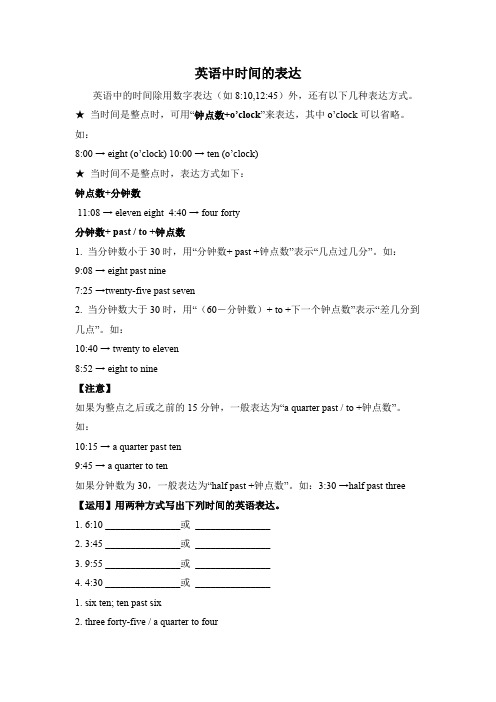
英语中时间的表达英语中的时间除用数字表达(如8:10,12:45)外,还有以下几种表达方式。
★当时间是整点时,可用“钟点数+o’clock”来表达,其中o’clock可以省略。
如:8:00 → eight (o’clock) 10:00 → ten (o’clock)★当时间不是整点时,表达方式如下:钟点数+分钟数11:08 → eleven eight 4:40 → four forty分钟数+ past / to +钟点数1. 当分钟数小于30时,用“分钟数+ past +钟点数”表示“几点过几分”。
如:9:08 → eight past nine7:25 →twenty-five past seven2. 当分钟数大于30时,用“(60-分钟数)+ to +下一个钟点数”表示“差几分到几点”。
如:10:40 → twenty to eleven8:52 → eight to nine【注意】如果为整点之后或之前的15分钟,一般表达为“a quarter past / to +钟点数”。
如:10:15 → a quarter past ten9:45 → a quarter to ten如果分钟数为30,一般表达为“half past +钟点数”。
如:3:30 →half past three 【运用】用两种方式写出下列时间的英语表达。
1. 6:10 _______________或_______________2. 3:45 _______________或_______________3. 9:55 _______________或_______________4. 4:30 _______________或_______________1. six ten; ten past six2. three forty-five / a quarter to four3. nine fifty- five / five to ten4. four thirty / half past four给大家推荐一个英语微信群Empty Your Cup英语微信群是目前学习英语最有效的方法,群里都是说英语,没有半个中文,而且规则非常严格,是一个超级不错的英语学习环境,群里有好多英语超好的超牛逼的人,还有鬼佬和外国美眉。
英语关于时间的用法

英语关于时间的用法英语中时间的用法有很多,以下是一些常见的表达方式:1. 表达某个时间点或某个时间段的常用方式:表示某个具体的时间点,可以使用介词at,例如:at 7 o'clock(在7点钟);at noon(在中午);at midnight(在午夜)。
表示某个时间段,可以使用介词for,例如:for 2 hours(两小时);for a week (一周);for a month(一个月)。
2. 表达过去时间的常用方式:表示过去某个时间点或时间段已经过去,可以使用过去时态,例如:I went to the party at 8 o'clock last night.(昨天晚上8点我去参加聚会。
)表示过去某个时间点或时间段正在发生的事情,可以使用过去进行时态,例如:We were having dinner at 6 o'clock yesterday.(昨天6点钟我们正在吃晚饭。
)3. 表达将来时间的常用方式:表示将来某个时间点或时间段将要发生的事情,可以使用将来时态,例如:I willarrive at the airport at 10 o'clock tomorrow morning.(明天上午10点我将到达机场。
)表示将来某个时间点或时间段可能发生的事情,可以使用将来进行时态或情态动词may/might,例如:They might arrive at the party at 11 o'clock tonight.(他们可能今晚11点到达聚会。
)4. 时间顺序的表达方式:表示先后顺序,可以使用first、second、third等词,例如:First we had breakfast, then we went to the park, and finally we came back home.(我们先吃早饭,然后去了公园,最后回家了。
)表示同时发生的事情,可以使用and连接两个动词或动名词短语,例如:He was singing and dancing at the same time.(他同时唱歌和跳舞。
英文中关于时间的表达
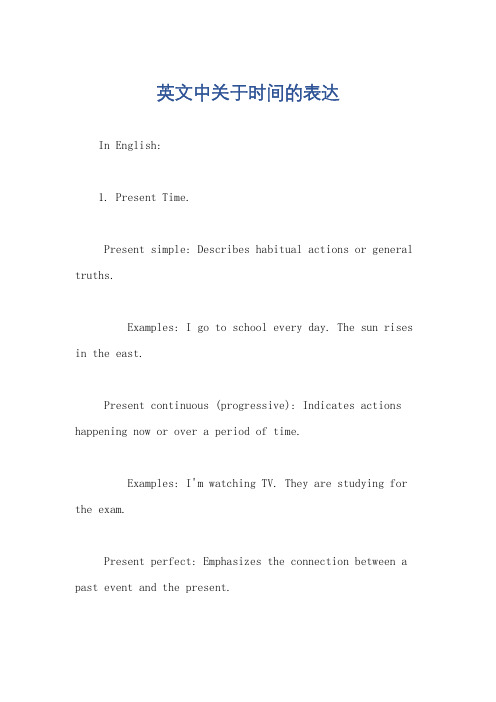
英文中关于时间的表达In English:1. Present Time.Present simple: Describes habitual actions or general truths.Examples: I go to school every day. The sun rises in the east.Present continuous (progressive): Indicates actions happening now or over a period of time.Examples: I'm watching TV. They are studying for the exam.Present perfect: Emphasizes the connection between a past event and the present.Examples: I have studied English for five years. She has just finished her work.Present perfect continuous: Focuses on the duration or ongoing nature of an action.Examples: I have been working on this project for two hours. They have been arguing for days.2. Past Time.Past simple: Refers to completed actions in the past.Examples: I went to the park yesterday. They played football last week.Past continuous (progressive): Describes actions taking place at a specific time in the past.Examples: I was sleeping when the phone rang. They were eating dinner at 8 pm.Past perfect: Indicates an action that occurred before another action in the past.Examples: I had finished my work before you arrived. She had lost her keys before she left the house.Past perfect continuous: Emphasizes the duration of an action prior to a point in the past.Examples: I had been waiting for the bus for an hour. They had been living in London for five years.3. Future Time.Future simple: Expresses actions that will happen at a specific time or in the future.Examples: I will meet you tomorrow. They will finish the project next month.Future continuous (progressive): Indicates actionsthat will be in progress at a specific time in the future.Examples: I will be studying at the library tonight. They will be traveling to Paris next summer.Future perfect: Conveys the idea that an action will be completed before another action in the future.Examples: I will have graduated by next year. She will have retired before she turns 60.Future perfect continuous: Highlights the duration of an action that will have been ongoing before a point in the future.Examples: I will have been working for this company for five years by next June. They will have been living in the same house for over a decade.4. Conditional Sentences.Zero conditional: Describes general truths or universal facts.Examples: If it rains, the ground gets wet. When you press the button, the light turns on.First conditional: Expresses a possible or probable event based on a condition.Examples: If I study hard, I will pass the exam.If you take a taxi, you will be there on time.Second conditional: Indicates a hypothetical or unlikely situation.Examples: If I were a millionaire, I would travel around the world. If it rained, the game would be canceled.Third conditional: Refers to events that did not happen in the past due to a different situation.Examples: If I had studied harder, I would have passed the test. If they had arrived on time, they would not have missed the flight.5. Relative Clauses.Defining relative clauses: Restrict or define the noun they modify.Examples: The book that I'm reading is very interesting. The man who lives next door is a doctor.Non-defining relative clauses: Provide additional information without defining the noun.Examples: The book, which I bought yesterday, is very interesting. The man, who is my neighbor, is a doctor.Relative adverbs: Connect a relative clause to a main clause and serve specific functions.Examples: Where I live is beautiful. The reason why I'm here is to help you.In Chinese:1. 现在时。
英语中的各种时间表达
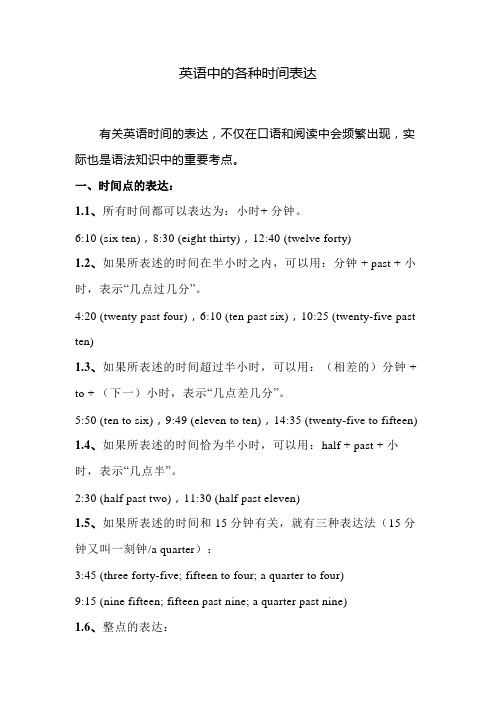
英语中的各种时间表达有关英语时间的表达,不仅在口语和阅读中会频繁出现,实际也是语法知识中的重要考点。
一、时间点的表达:1.1、所有时间都可以表达为:小时+ 分钟。
6:10 (six ten),8:30 (eight thirty),12:40 (twelve forty)1.2、如果所表述的时间在半小时之内,可以用:分钟 + past + 小时,表示“几点过几分”。
4:20 (twenty past four),6:10 (ten past six),10:25 (twenty-five past ten)1.3、如果所表述的时间超过半小时,可以用:(相差的)分钟 + to + (下一)小时,表示“几点差几分”。
5:50 (ten to six),9:49 (eleven to ten),14:35 (twenty-five to fifteen) 1.4、如果所表述的时间恰为半小时,可以用:half + past + 小时,表示“几点半”。
2:30 (half past two),11:30 (half past eleven)1.5、如果所表述的时间和15分钟有关,就有三种表达法(15分钟又叫一刻钟/a quarter):3:45 (three forty-five; fifteen to four; a quarter to four)9:15 (nine fifteen; fifteen past nine; a quarter past nine)1.6、整点的表达:现在是两点整。
It's two. / It's two o'clock. 注:noon和midnight 可分别直接表示白天和夜晚的12点。
It's (twelve) noon. 现在是中午十二点。
It's (twelve) midnight. 现在是半夜零点。
1.7、大约的时间:It's almost two. 马上到两点了。
英语中的各种时间表达
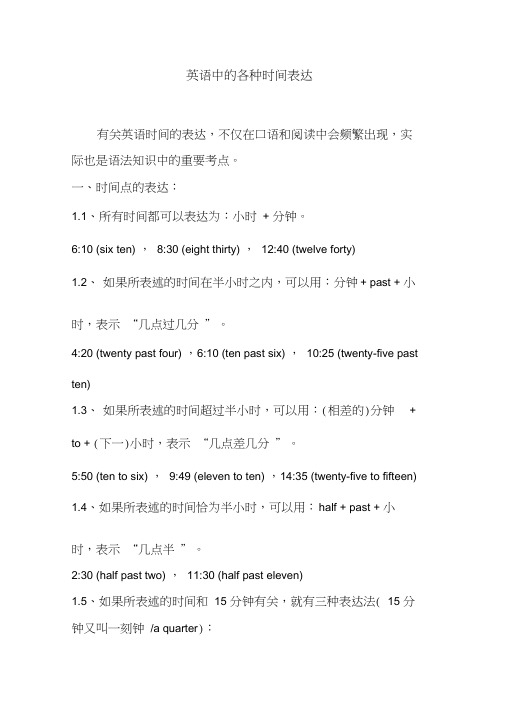
英语中的各种时间表达有关英语时间的表达,不仅在口语和阅读中会频繁出现,实际也是语法知识中的重要考点。
一、时间点的表达:1.1、所有时间都可以表达为:小时+ 分钟。
6:10 (six ten) ,8:30 (eight thirty) ,12:40 (twelve forty)1.2、如果所表述的时间在半小时之内,可以用:分钟+ past + 小时,表示“几点过几分”。
4:20 (twenty past four) ,6:10 (ten past six) ,10:25 (twenty-five past ten)1.3、如果所表述的时间超过半小时,可以用:(相差的)分钟+ to + (下一)小时,表示“几点差几分”。
5:50 (ten to six) ,9:49 (eleven to ten) ,14:35 (twenty-five to fifteen) 1.4、如果所表述的时间恰为半小时,可以用:half + past + 小时,表示“几点半”。
2:30 (half past two) ,11:30 (half past eleven)1.5、如果所表述的时间和15 分钟有关,就有三种表达法( 15 分钟又叫一刻钟/a quarter):3:45 (three forty-five; fifteen to four; a quarter to four) 9:15 (nine fifteen;fifteen past nine; a quarter past nine)1.6、整点的表达:现在是两点整。
It's two. / It's two o'clock. 注:noon 和midnight 可分别直接表示白天和夜晚的12 点。
It's (twelve) noon. 现在是中午十二点。
It's (twelve) midnight. 现在是半夜零点。
1.7、大约的时间:It's almost two. 马上到两点了。
英语中时间的最全表达和用法
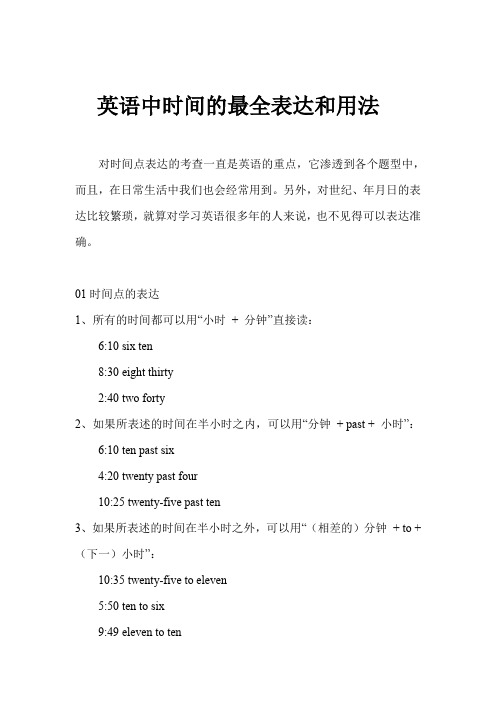
英语中时间的最全表达和用法对时间点表达的考查一直是英语的重点,它渗透到各个题型中,而且,在日常生活中我们也会经常用到。
另外,对世纪、年月日的表达比较繁琐,就算对学习英语很多年的人来说,也不见得可以表达准确。
01时间点的表达1、所有的时间都可以用“小时+ 分钟”直接读:6:10 six ten8:30 eight thirty2:40 two forty2、如果所表述的时间在半小时之内,可以用“分钟+ past + 小时”:6:10 ten past six4:20 twenty past four10:25 twenty-five past ten3、如果所表述的时间在半小时之外,可以用“(相差的)分钟+ to + (下一)小时”:10:35 twenty-five to eleven5:50 ten to six9:49 eleven to ten4、如果所表述的时间恰好为半小时,可以用“half + past + 小时”:11:30 half past eleven2:30 half past two5、如果所表述的分钟和15有关,就有三种表达法:(15分钟又叫一刻钟:a quarter)9:15 nine fifteen ; fifteen past nine ; a quarter past nine3:45 three forty-five ; fifteen to four ; a quarter to four6、整点的表达:现在是两点整。
It's two./It's two o clock.另外英语中的noon 和midnight 可分别直接表示白天和夜晚的12点:It's (twelve) noon. 现在是中午十二点。
It's (twelve) midnight. 现在是半夜零点。
7、大约时间:It's almost two. 马上到两点了。
英语中的时间表达法
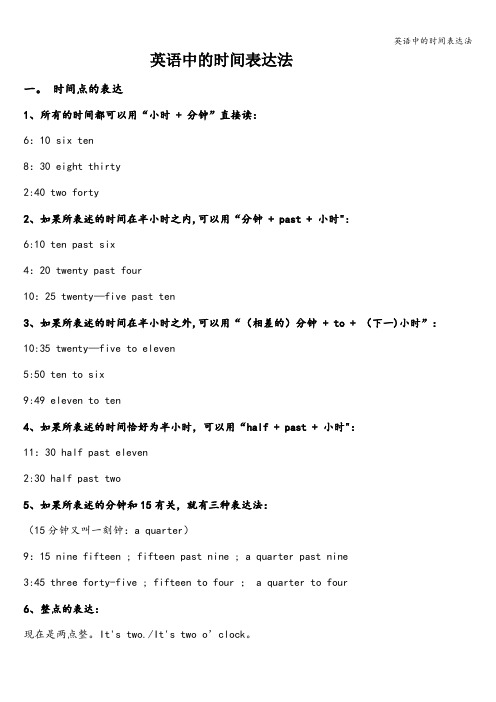
英语中的时间表达法一。
时间点的表达1、所有的时间都可以用“小时 + 分钟”直接读:6:10 six ten8:30 eight thirty2:40 two forty2、如果所表述的时间在半小时之内,可以用“分钟 + past + 小时":6:10 ten past six4:20 twenty past four10:25 twenty—five past ten3、如果所表述的时间在半小时之外,可以用“(相差的)分钟 + to + (下一)小时”:10:35 twenty—five to eleven5:50 ten to six9:49 eleven to ten4、如果所表述的时间恰好为半小时,可以用“half + past + 小时":11:30 half past eleven2:30 half past two5、如果所表述的分钟和15有关,就有三种表达法:(15分钟又叫一刻钟:a quarter)9:15 nine fifteen ; fifteen past nine ; a quarter past nine3:45 three forty-five ; fifteen to four ; a quarter to four6、整点的表达:现在是两点整。
It's two./It's two o’clock。
另外英语中的 noon 和midnight 可分别直接表示白天和夜晚的12点:It’s (twelve) noon。
现在是中午十二点。
It's (twelve) midnight。
现在是半夜零点。
7、大约时间:It's almost two。
马上到两点了。
It’s not quite two. 还不到两点.It’s jus t after two。
刚过两点。
8、若想表明是上午,可在时间后加上a。
m.如:thirteen past six a。
英文中的时间表达(全)
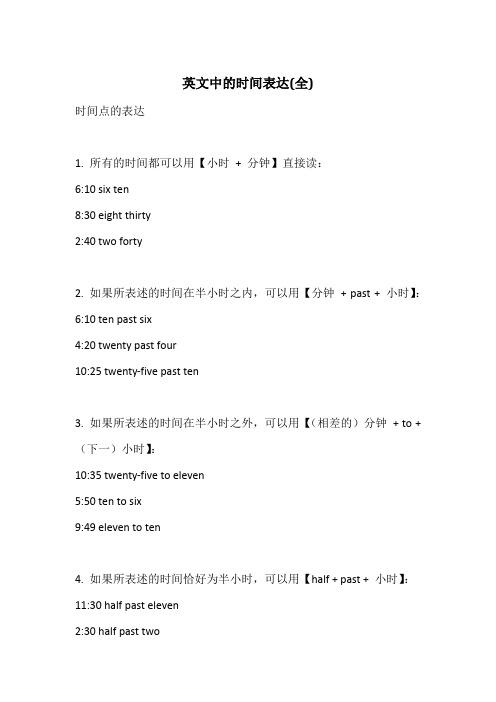
英文中的时间表达(全)时间点的表达1. 所有的时间都可以用【小时+ 分钟】直接读:6:10 six ten8:30 eight thirty2:40 two forty2. 如果所表述的时间在半小时之内,可以用【分钟+ past + 小时】:6:10 ten past six4:20 twenty past four10:25 twenty-five past ten3. 如果所表述的时间在半小时之外,可以用【(相差的)分钟+ to + (下一)小时】:10:35 twenty-five to eleven5:50 ten to six9:49 eleven to ten4. 如果所表述的时间恰好为半小时,可以用【half + past + 小时】:11:30 half past eleven2:30 half past two5. 如果所表述的分钟和15有关,就有三种表达法:(15分钟又叫一刻钟:a quarter)9:15nine fifteen ; fifteen past nine ; a quarter past nine3:45three forty-five ; fifteen to four ; a quarter to four夫妻不和感情不顺,添加师兄vipp3200为你解忧。
6. 整点的表达:It's two./It's two o'clock.现在是两点整。
(另外英语中的noon 和midnight 可分别直接表示白天和夜晚的12点)现在是中午十二点。
It's (twelve) noon.现在是半夜零点。
It's (twelve) midnight.7. 大约时间:It's almost two.马上到两点了。
It's not quite two.还不到两点。
It's just after two.刚过两点。
用英语表示时间的三种用法
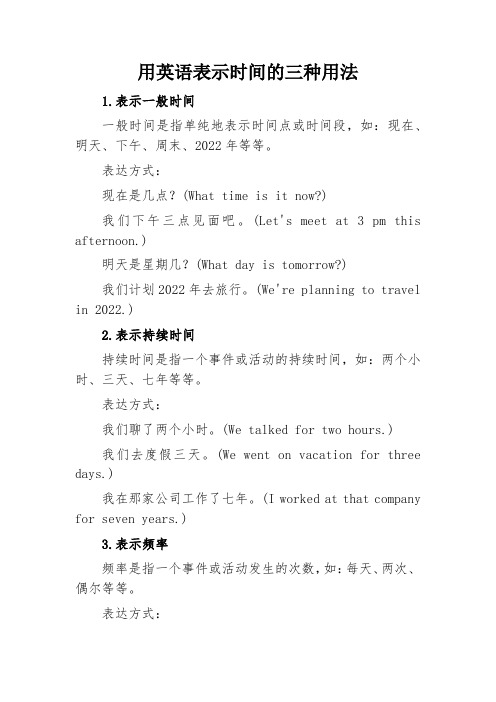
用英语表示时间的三种用法
1.表示一般时间
一般时间是指单纯地表示时间点或时间段,如:现在、明天、下午、周末、2022年等等。
表达方式:
现在是几点?(What time is it now?)
我们下午三点见面吧。
(Let's meet at 3 pm this afternoon.)
明天是星期几?(What day is tomorrow?)
我们计划2022年去旅行。
(We're planning to travel in 2022.)
2.表示持续时间
持续时间是指一个事件或活动的持续时间,如:两个小时、三天、七年等等。
表达方式:
我们聊了两个小时。
(We talked for two hours.)
我们去度假三天。
(We went on vacation for three days.)
我在那家公司工作了七年。
(I worked at that company for seven years.)
3.表示频率
频率是指一个事件或活动发生的次数,如:每天、两次、偶尔等等。
表达方式:
我每天早上六点起床。
(I wake up at 6 am every day.) 我们一周开两次会。
(We have meetings twice a week.) 我偶尔会去购物中心。
(I occasionally go to the mall.)。
- 1、下载文档前请自行甄别文档内容的完整性,平台不提供额外的编辑、内容补充、找答案等附加服务。
- 2、"仅部分预览"的文档,不可在线预览部分如存在完整性等问题,可反馈申请退款(可完整预览的文档不适用该条件!)。
- 3、如文档侵犯您的权益,请联系客服反馈,我们会尽快为您处理(人工客服工作时间:9:00-18:30)。
一. 时间点的表达
1. 所有的时间都可以用“小时+ 分钟”直接读:
6:10 six ten
8:30 eight thirty
2:40 two forty
2. 如果所表述的时间在半小时之内,可以用“分钟+ past + 小时”:
6:10 ten past six
4:20 twenty past four
10:25 twenty-five past ten
3. 如果所表述的时间在半小时之外,可以用“(相差的)分钟+ to + (下一)小时”:10:35 twenty-five to eleven
5:50 ten to six
9:49 eleven to ten
4. 如果所表述的时间恰好为半小时,可以用“half + past + 小时”:
11:30 half past eleven
2:30 half past two
5. 如果所表述的分钟和15有关,就有三种表达法:
(15分钟又叫一刻钟: a quarter)
9:15 nine fifteen ; fifteen past nine ; a quarter past nine
3:45 three forty-five ; fifteen to four ; a quarter to four
6. 整点的表达:
现在是两点整。
It's two./It's two o'clock.
另外英语中的noon 和midnight 可分别直接表示白天和夜晚的12点:It's (twelve) noon. 现在是中午十二点。
It's (twelve) midnight. 现在是半夜零点。
7. 大约时间:
It's almost two. 马上到两点了。
It's not quite two. 还不到两点。
It's just after two. 刚过两点。
8. 若想表明是上午,可在时间后加上.
如:thirteen past six .(上午六点十三分)。
若想表明是下午,可在时间后加上.
如:four o'clock .(下午四点)。
9. 句子范例
①It's nine forty-five. =It's a quarter to ten.
②It's two seventeen. =It's seventeen past two.
③It's three. =It's three o'clock.
④It's nine thirty. =It's half past nine.
⑤It's six fifteen. =It's a quarter past six.
⑥It's three fifty. =It's ten to four.
二. 世纪、年代、年、月、日的表达
1. 世纪
(1)用“定冠词+序数词+century”表示
例:在十七世纪写作:in the 17th century,读作:in the seventeenth century
(2)用“定冠词+百位进数+s”表示
例:在十七世纪写作:in the 1600s,读作:in the sixteen hundreds
注意:这种情况下,实际表达的世纪数是阿拉伯数字本身加一。
2. 年代
用“定冠词+(世纪百位进数+十位年代数)+s”表示
例:在二十世纪三十年代写作:in the 1930s,读作:in the thirties of the twentieth century或in the nineteen thirties
表示某年代的早期、中期和晚期,可以在定冠词后添加early, mid-和late
例如:在二十世纪二十年代早期in the early 1920s;
在二十世纪五十年代中期in the mid-1950s
3. 年月日
(1)年份
①读年份时一般分为两个单位来读,前两个数为一个,后两个数为一个:
1949 读作:nineteen forty-nine或nineteen hundred and forty-nine
②如果是三位数,先读第一位,再把后两个数合起来读:
253 读作:two fifty-three或two hundred and fifty-three
③另外:2000 读作:two thousand,1902 读作:nineteen hundred and two或nineteen o two
④如果要使用year,year放在数词之前
例如:in the year two fifty-three . 在公元前253年
(2)月份
月份是专有名词,除了少数几个月份外都有缩写形式:
January - Jan. 一月
February - Feb. 二月
March - Mar. 三月
April - Apr. 四月
August - Aug. 八月
September - Sept. 九月
October - Oct. 十月
November - Nov. 十一月
December - Dec. 十二月
注意:缩写形式后面的点不能省略,因为它是表示缩写形式的符号。
(3)日期
用序数词表示
例:十月一日写作:October 1, October 1st, 1 October, 1st October, (the) 1st of
October等,其中的October都可以写成缩写形式Oct.
读作:October the first或the first of October
(4)年月日
用英语表达年月日的顺序:
①月日年
例:2002年1月17日
写作:January 17(th), 2002或January seventeenth, 2002(日和年之间需用逗号隔开)读作:January the seventeenth, two thousand and two
②日月年
例:2002年1月17日
写作:17(th) January, 2002或the seventeenth of January, 2002(月和年之间需用逗号隔开)
读作:the seventeenth of January, two thousand and two
4. 介词的使用
若指在哪一年或哪一月,用介词in;若具体到某一天,需用介词on。
例如:
She was born in 1989.
She was born in August.
She was born in August 1989.
She was born on 2nd August, 1989.。
